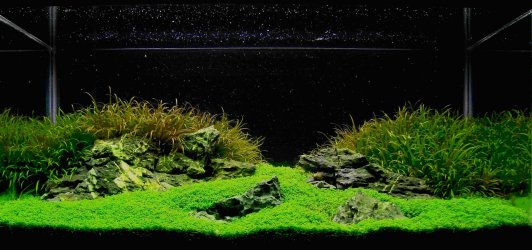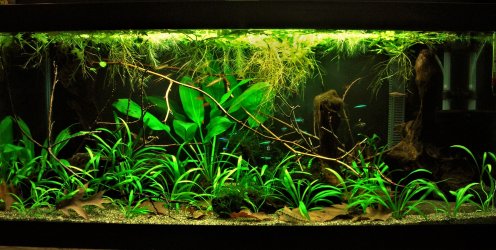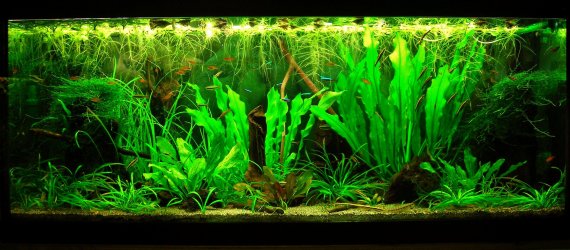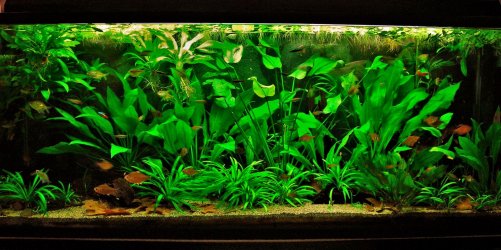I've scrapped the "algae eater" idea somewhat. After doing minimal research, most places say I don't need algae eaters and they aren't necessarily effective and that they're needed is somewhat fish store propaganda. Is this true?
Yes, to a certain exztent. Stores may sell certain fish as "algae eaters" and the aquarist takes them home thinking they will keep the aquarium free of algae. No fish will do this. And algae is natural and beneficial and part of a healthy ecosystem. We aim to keep it under control, especially in planted tanks, as it can encrust plant leaves to the degree of killing the leaf and the plant.
There are many species of algae, and none of these so-called "algae eating" fish will eat all of them. It can be beneficial to have something that eats some of the common green algae that will be part of the bio-film that develops on all surfaces covered by water; this is often unseen until it increases significantly, and some fish are good at eating some of this. Diatoms or brown algae is usually eaten by the fish that will graze the common green algae. Such fish include otos, Farlowella (Twig Catfish), Bristlenose plecos, Whiptail catfish, Spotted headstander, mollies, and some rift lake cichlids. Generally, any vegetarian fish is likely to eat this common algae. But not usually to the extent that it will solve problem outbreaks of algae. And none of those mentioned will eat (or it will be soo minimal as to be near zero) true "problem" algae species like brush and beard; these must be controlled by the balance of light/nutrients. [Common snails also eat algae, but again not to the extent they can clean up a problem.]
I have all of the fish I just mentioned (except Bristlenose presently) in various tanks, because I value them as a fish species in itself; I do not have them to control algae, but their effort in keeping common algae minimal is appreciated as I have live plants in all my tanks. I am careful which species goes in which tank, and how many of them, because these fish really do need to have algae in their diet. All of them will learn to eat algae-based sinking foods, but initially they tend to settle in faster and more reliably with algae present. But I am careful not to overload any tank with these fish.
Some of these have individual requirements too. The one or two species not mentioned above that will tackle problem algae (some of it anyway) get large and are unsuitable for most aquaria. Fish should never be acquired sole3ly to hopefully solve a problem; if one like this or that species, and the species has the benefit of "helping" with this or that, fine. But the fish must be provided with what it "expects," and should be a species the aquarist finds interesting as a fish.
Is 250gph diffused through 11 holes on a 10" spray bar to much? So 22gph per each hole, with just less of an inch between, so I reckon good flow, but not horrible?
I can only judge water flow by seeing it. But there are ways to minimize direct current. In my larger tanks with canister filters, the 70g is a flooded Amazon forest display, so I use the spraybar and direct the holes into the end wall on one side, and you can adjust the angle to get decent surface disturbance (which is important). The flow down the tank wall and then across the tank to the opposite end (where the intake should be positioned) will be much less forceful, than if you aim the holes down parallel to the wall. Placing solid décor like standing chunks of wood (representing tree trunks) or rock to divert the flow from the filter can also help in some situations.
There is a myth in the hobby that larger filters, or more of them, benefit. They do not. Provided the filter is suited to the tank volume, it will do the job (if maintained, and the tank is not overstocked, or mis-stocked). "More filtration" is not possible; any filter can only filter what is biologically possible, no more, so having larger filters or more of them is not going to somehow increase filtration. Biology/nature doesn't work like that.
Yes, that would be an issue. I am going to have 240 leds, ~8000 lumens, over the whole tank. However, it will be approx. 8" above the tank, with a 16" depth, so 24" diffused across a 3' tank. Are there any other schooling fish that don't have a problem with light? I read about photophobia the other day, but I thought it was only genetic in neon's and other inbred species, my bad. *Also, I really DON'T want floating plants. I find them unattractive, but if the fish need it, I'll do it.
I'm not very technical with lumens and such. My tanks all have moderate (or low) lighting that will be sufficient for the plants, plus they all have floating plants. If this or that plant won't survive, I move on to another species that will under my lighting, because the fish must come first. The plants are there to help the fish and the biological system, but are not the prime focus.
Most of our fish are forest fish and they live in dimly lit waters. This lack of light can be due to the forest canopy, marginal vegetation, or suspended particulate matter in the water. Evolution has programmed this into the fish so it must be kept in mind.
I have floating plants in all tanks, and they tend to pretty well cover the surface. Floaters are the best filtration, so that is a benefit too. But thinking only of light...I have more than once observed fish reacting when the floaters have been thinned out (they have to be, they grow so fast in my tanks) by remaining lower in the tank for several days until the floating plants are more widespread. These fish also pale in colouration when the light increases. And in a tank that might have few or no floaters at first, as soon as I add them the fish move up and out. You can achieve this with terrestrial plants over the tank, but only if they are between the light and the water obviously. We need to keep in mind that as far as fish health goes, they would be very happy with no tank lighting, just ambient light from the room windows/lights. This is not good though, because we cannot see the fish and that is why we have them. I did an experimental 10g with no filter and no tank light; I had in in front of a west facing window and the light was certainly adequate for the plants, and the fish were fine--but I could hardly see them. After a year, I moved the tank away from the window, added an overhead light and a sponge filter; not surprisingly, the fish remained down among plants for a few weeks before they would again venture out as they had without the overhead lighting.
So, we've scrapped corydoras, cardinal tetras, otos. I don't know what to do guys.
You need to decide on having a tank with fish, or a tank that is more of an aquatic garden.

Below are photos of some of my South American aquascapes over the past few years.




 Below are photos of some of my South American aquascapes over the past few years.
Below are photos of some of my South American aquascapes over the past few years.


